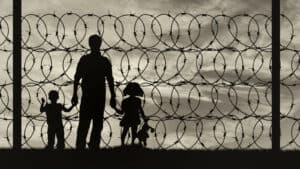With Donald Trump’s return to the White House looming in January, Canadian officials and community organizations are bracing for a potential rise in irregular migration across the US-Canada border. Trump’s pledge to initiate mass deportations of undocumented immigrants has sparked concerns about a new influx of asylum seekers, recalling the surge Canada experienced after his 2016 election. Back then, thousands of migrants sought refuge in Canada, often crossing through unguarded border areas such as Roxham Road, an unofficial border crossing between the United States and Canada, located in Champlain, New York, and leading into Saint-Bernard-de-Lacolle, Quebec.
A Repeat of 2017
In 2017, Roxham Road became a notable entry point, as thousands of asylum seekers walked into Canada to claim refugee status, driven by Trump’s strict immigration policies. The Safe Third Country Agreement (STCA), which requires asylum seekers to apply in the first “safe” country they reach, pushed migrants to this unofficial crossing to bypass the STCA’s limitations at official ports of entry. By 2023, however, Canada and the US amended the STCA, expanding it to include the entire land border and closing routes like Roxham Road.
Jennifer Elrick, a McGill University sociology professor specializing in immigration, said the closure of Roxham Road might increase attempts through other, possibly riskier, remote crossings, raising safety concerns as migrants try to navigate harsh winter conditions or unfamiliar terrain.
Safety Concerns and Community Preparations
Community organizations, such as Montreal’s Welcome Collective, are preparing to respond; the group previously assisted newcomers crossing at Roxham Road. Melissa Claisse, the group’s communications coordinator, warns of the possible danger. “It’s very possible we’re going to see people in remote areas in mid-winter, and we’ve already seen people dying in situations like that,” she said. This grim reality underscores the risks migrants may take, believing Canada is a safe harbour from Trump’s policies.
No related posts.
As the US election results were announced, Canadian law enforcement agencies, including the RCMP, are finalizing contingency plans. RCMP Sergeant Charles Poirier, based in Montreal, said officers are prepared for multiple scenarios, ranging from a minor uptick in crossings to a massive influx. Poirier noted that the closure of Roxham Road has led to a drop in illegal entries but has redirected some activity to other areas, making policing efforts more challenging. “If people start crossing everywhere on the territory like the southbound are doing, that is going to be much more difficult,” he said, stressing the need for a coordinated response to manage potential increases in unauthorized entry.
Political Response
Politicians are also responding to this anticipated influx. Quebec Premier François Legault said Canada must safeguard its border, while Parti Québécois Leader Paul St-Pierre Plamondon expressed concerns that millions might consider migrating north if Trump implements mass deportations. The discourse highlights the tension between provincial resource capacities and federal immigration policies. To address such issues, Prime Minister Justin Trudeau has reactivated a Canada-US relations cabinet committee, which includes key ministers responsible for immigration and public safety.
Foreign Affairs Minister Mélanie Joly affirmed Canada’s commitment to a balanced immigration approach, stressing the importance of maintaining public trust. Recently, Canada lowered its immigration targets by 20 percent to manage the flow of newcomers effectively and sustainably. “We want a migration system that Canadians trust… we will defend it,” Joly said.
Despite Joly’s assurances, immigration advocates and opposition politicians urge Ottawa to develop a proactive humanitarian plan. NDP MP Jenny Kwan called for transparency, saying, “What needs to happen is for them to be open and transparent with Canadians.” Ensuring preparedness at the border and readiness to provide essential services could be critical in mitigating the pressures of a sudden increase in asylum seekers.
Border Security
While declining to share specific plans, the Canada Border Services Agency (CBSA) has acknowledged that it operates in a dynamic environment and is prepared to adapt to changing circumstances. Meanwhile, RCMP teams across the country communicate with domestic and US partners, drawing from experiences over the past decade to build a robust response framework.
The preparations involve increased staffing, more resources allocated to high-risk areas, and contingency plans for surges, particularly in rural communities like Emerson-Franklin, Manitoba, where the Pembina-Emerson crossing that connects the US city of Pembina, North Dakota and the Canadian community of Emerson, Manitoba has seen significant traffic.
Emerson-Franklin Reeve Dave Carlson is cautiously optimistic, recalling the area’s challenges in 2017. “We’re all very interested to see what the response will be,” Carlson said, underscoring the necessity of a federal response that doesn’t overburden local communities. According to Carlson, past migrant surges placed heavy demands on local emergency resources and stretched the limits of community support systems.
New Migration Landscape
While the possibility of a migration surge looms, experts like Muzaffar Chishti of the Migration Policy Institute said the situation is not yet guaranteed. Chishti believes many migrants may take a “wait-and-see” approach, given that Trump’s rhetoric does not always translate directly into policy. Nevertheless, how Canada handles the border situation will significantly affect whether migrants seek refuge here. “If they believe that there is no welcome mat in Canada, they’re not going to go,” he said.
Yet the unpredictability of such scenarios keeps community groups and law enforcement on high alert. If the anticipated increase materializes, Canada will revisit the same challenges that emerged in 2017 under new and potentially more complex circumstances.
In 2017, Trudeau tweeted that Canada would welcome those fleeing persecution. That message symbolized Canada’s openness and sparked inquiries from hopeful asylum seekers. This time, however, Canada’s approach may focus on balancing humanitarian commitments with the limitations of a sustainable immigration system. As Trump’s policies evolve and border pressures mount, Canada’s response will not only shape its immigration landscape but also its relationship with a potentially more restrictive neighbour to the south.
Canada Irregular Migration FAQ
Why is Canada expecting a rise in irregular migration?
Canada anticipates increased migration as Donald Trump’s potential return to the White House raises concerns over mass deportations in the U.S. This mirrors a 2017 surge when migrants sought asylum in Canada due to Trump’s restrictive immigration policies.
How did the closure of Roxham Road impact asylum seekers?
Closing Roxham Road, a popular irregular entry point, reduced illegal entries but may push migrants to riskier, remote crossings. This raises safety concerns as some may attempt dangerous crossings in harsh conditions to bypass the Safe Third Country Agreement.
What actions are Canadian law enforcement taking?
The RCMP and Canada Border Services Agency (CBSA) are preparing for a range of scenarios. These include staffing increases, resource allocation to high-risk areas, and collaborating with U.S. partners to manage potential migration surges effectively.
What role do community organizations play in this situation?
Groups like Montreal’s Welcome Collective are preparing to support newcomers, providing essential resources and assistance. Their focus includes addressing safety risks for migrants who may attempt crossings in unfamiliar, possibly hazardous areas.
How are Canadian politicians responding to this potential surge?
Political leaders emphasize securing the border and balancing immigration policies. Prime Minister Trudeau’s cabinet committee on Canada-U.S. relations is tasked with coordinating responses, while Minister Mélanie Joly affirms the need for public trust in a balanced immigration system.





